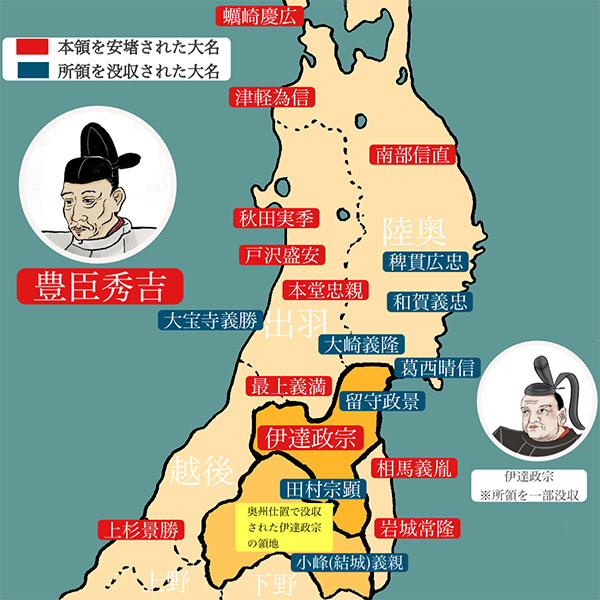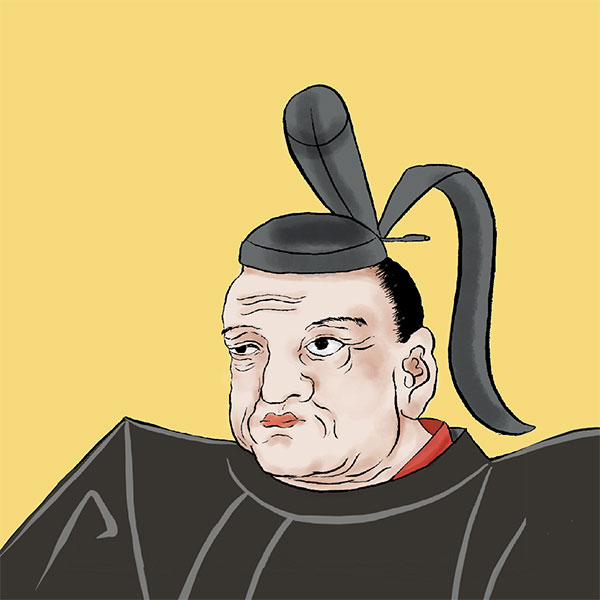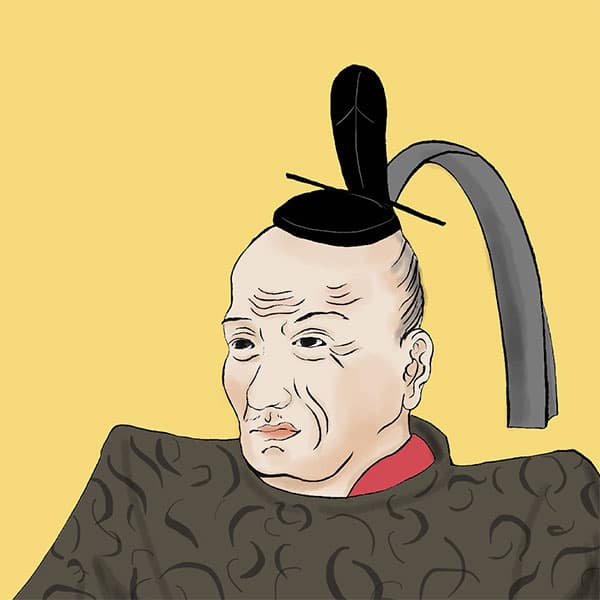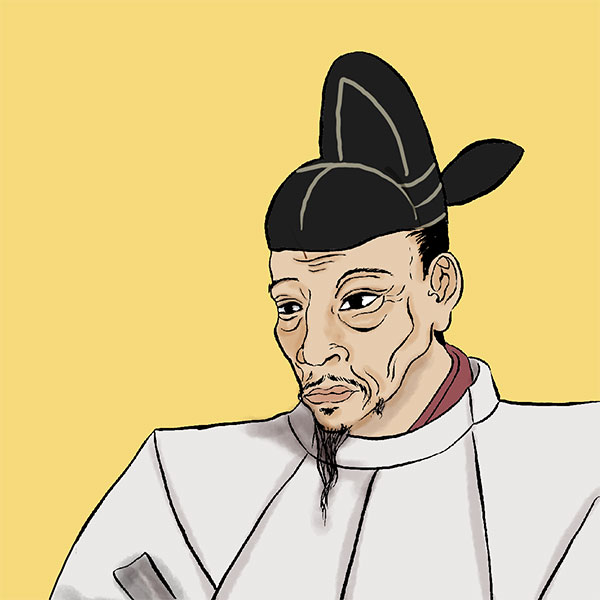Oshu punishment (1/2)Toyotomi Hideyoshi pacified Tohoku, causing ripples.

Oshu Punishment
- Article category
- case file
- Incident name
- Oshu Shioki (1590)
- place
- Miyagi prefecture, Fukushima prefecture, Iwate prefecture, Aomori prefecture, Yamagata prefecture, Akita prefecture
- Related castles

Sendai Castle

Yamagata Castle

Tsuruga Castle

Hanamaki Castle
From July to August 1590, Toyotomi Hideyoshi carried out the territorial control of the Tohoku region as the final stage of unifying the country, called ``Oshu Shioki.'' At that time, the Tohoku region consisted of Mutsu Province (present-day Fukushima, Miyagi, Iwate, and Aomori prefectures) and Dewa Province (Yamagata and Akita prefectures), so it was called ``Ou'', and for this reason it was also known as ``Ou Shioki''. ” is also said. This time, I will explain the Oshu Shioki, which was Hideyoshi's arbitrary distribution of territory, which later led to numerous uprisings and rebellions.
Background of Oshu Shioki, “Odawara Conquest”
The battle that formed the backdrop for Oshu Shioki was the Odawara Conquest, in which Toyotomi Hideyoshi fought against the Hojo clan from the beginning of 1590 to July. Hideyoshi conquered Shikoku in 1585 and Kyushu in 1587, leaving only Kanto and Tohoku until the country was unified. The Hojo clan, which was a major force ruling the Kanto region, was a nuisance to Hideyoshi. Hideyoshi thought he could somehow eliminate them or incorporate them into his subordinates to unify the country.
Hideyoshi first calls on Ujimasa Hojo and Ujinao to come to Kyoto and serve as his vassals, but the Hojo clan continues to refuse to come to Kyoto. Then, in 1589, Hideyoshi, at the request of the Hojo clan, decided in favor of the Hojo clan regarding the territorial issue of Ueno Province and Numata territory (Numata City, Gunma Prefecture), which the Hojo clan was in dispute with the Sanada clan. Force the solution. According to Hideyoshi's decision, known as the ``Numata Arbitration'', 20,000 koku of the 30,000 koku of Numata territory was given to the Hojo clan and 10,000 koku to the Sanada clan. Numata territory is a transportation hub and an important strategic base in northern Kanto. No wonder Mr. Hojo wanted it.
Hideyoshi must have thought, ``I've done myself a favor to the Hojo clan!'' and once again urged him to come to Kyoto. However, Mr. Hojo kept postponing his move to Kyoto. Seeing this response, Hideyoshi gradually began to move to subjugate the Hojo clan.
In October of the same year, Kuninori Inomata from the Hojo side captured Meikumo Castle in Sanada territory in Numata. Hideyoshi was furious at Numata's actions that contradicted his decision. Furthermore, there was an incident in which Ujikuni Hojo attacked Kunitsuna Utsunomiya in Shimotsuke Province (Tochigi Prefecture) without permission. This action was in violation of the ``Sōan Rei'' (prohibiting arbitrary fights between feudal lords) issued by Hideyoshi in 1585.
As a result of these incidents accumulating, Hideyoshi decided to conquer Odawara, and from around November he notified the generals that he would be heading out to subjugate the Hojo clan next spring. In February of the following year, 1590, he led a large army of 210,000 men and began the conquest of Odawara.
The Odawara Conquest was not simply a battle between Toyotomi Hideyoshi and the Hojo clan. Toyotomi Hideyoshi ordered military commanders from all over the country to participate in the battle in addition to his own subordinates, and various military commanders gathered there, including Hideyoshi Tokugawa Hideyoshi, Maeda Toshiie, and Uesugi Kagekatsu. Participants from the Tohoku region include Nobunao Nanbu from Mutsu Province (Aomori Prefecture). The Odawara conquest was a battle to defeat the Hojo clan, but it was also a battle to confirm whether or not to follow Hideyoshi.
Hideyoshi led a large army of approximately 100,000 men and besieged Odawara Castle, where the Hojo clan was holed up. The Hojo clan was holed up in Odawara Castle for about 100 days, but on July 5th, Hojo Ujinao advised them to surrender. Odawara Castle was surrendered on July 11th, and the Odawara Conquest came to an end.
"Shioki" announced in Utsunomiya and Aizu
Toyotomi Hideyoshi finished the Odawara conquest. In order to unify the country, we will immediately begin dealing with the remaining Tohoku region. He left Kamakura for Shimotsuke Province on July 17th, and entered Utsunomiya Castle on the 26th. Here, he gathered together the feudal lords of Kanto and Ou, and after the conquest of Odawara, the territory of the Hojo family and parts of northern Kanto and Tohoku were distributed. The decision here is called ``Utsunomiya Shioki.'' Hideyoshi distributed territory in Utsunomiya when Minamoto no Yoritomo visited Utsunomiya Daimyojin to worship at Utsunomiya Daimyojin and subdued Oshu during the Battle of Oshu (battle with Oshu Fujiwara clan and Minamoto no Yoshitsune) in 1189. It is said to have become popular.
Masamune Date also rushed to Utsunomiya on July 28th. It seems that Masamune was asked by Hideyoshi for an opinion on the content of the punishment, but he ended up being two days late. Furthermore, during the Odawara conquest, Masamune was unsure whether to join Hideyoshi or not, and entered the war late in June. At this time, he is facing Hideyoshi in white clothes.
Afterwards, Hideyoshi, under Masamune's guidance, toured Oshu with the Oshu Shioki Army, which consisted of Ujisato Gamo and Nagamasa Asano. The Oshu Shioki Army continued northward and arrived at Shirakawa (Shirakawa City, Fukushima Prefecture) on August 6th. On the way, he was attacked by the Kasai clan of Mutsu Province, but he fought them off and entered Aizu Kurokawa Castle (currently Aizu Wakamatsu Castle) on the 9th. So Hideyoshi carried out the remaining punishment. He decided on the treatment of the Kasai clan and other foreign lords who did not participate in the Odawara conquest. At this time, it was decided that Ujisato Gamo would become the new lord of Aizu.
Hideyoshi left Aizu around August 15th and returned to Kyoto in September, but the Oshu Shioki army continued to advance north. Then, Nagamasa Asano moved into Toriyagasaki Castle (Hanamaki City, Iwate Prefecture), which had been the castle of the Hidenuki clan and had been forfeited for not participating in the Odawara conquest. The base was Toritanigasaki Castle, which is now called "Hanamaki Castle." Eventually, the Oshu Shioki army advanced to the area around Hiraizumi, Iwate Prefecture, and overran the local lords, including the Waga clan. After that, Nagamasa's vassals remained in each region as magistrates, carrying out land surveys and other tasks at Hideyoshi's orders, and promoting the transition to a new system. In September, the Oshu Shioki Army withdrew, leaving behind the magistrates.
What is the specific content of Oshu punishment?
The territorial measures taken by the Oshu Shioki had favorable results for the military commanders who participated in the Odawara conquest. The details will be discussed later, but for example, they granted Nanbu Nobunao control of seven districts of the Nanbu territory, and recognized Nobunao as the head of the Nanbu clan. On the other hand, Date Masamune was criticized for not only being late to the Odawara conquest, but also for attacking Ashina Yoshihiro in Aizu in the ``Battle of Suriuehara'' in Tensho 17 (1589), ignoring the Sōkin edict. The 1.14 million koku was reduced to 720,000 koku by confiscating the four districts of Aizu and other areas.

- WriterNaoko Kurimoto(Writer)I am a former travel industry magazine reporter. I have loved history, both Japanese and world history, since I was a child. I usually enjoy visiting temples and shrines, especially shrines, and often do ``pilgrimages to sacred places'' themed around historical figures. My favorite military commander is Ishida Mitsunari, my favorite castle is Kumamoto Castle, and my favorite castle ruins is Hagi Castle. My heart flutters when I see the ruins of battle castles and the stone walls of castle ruins.










